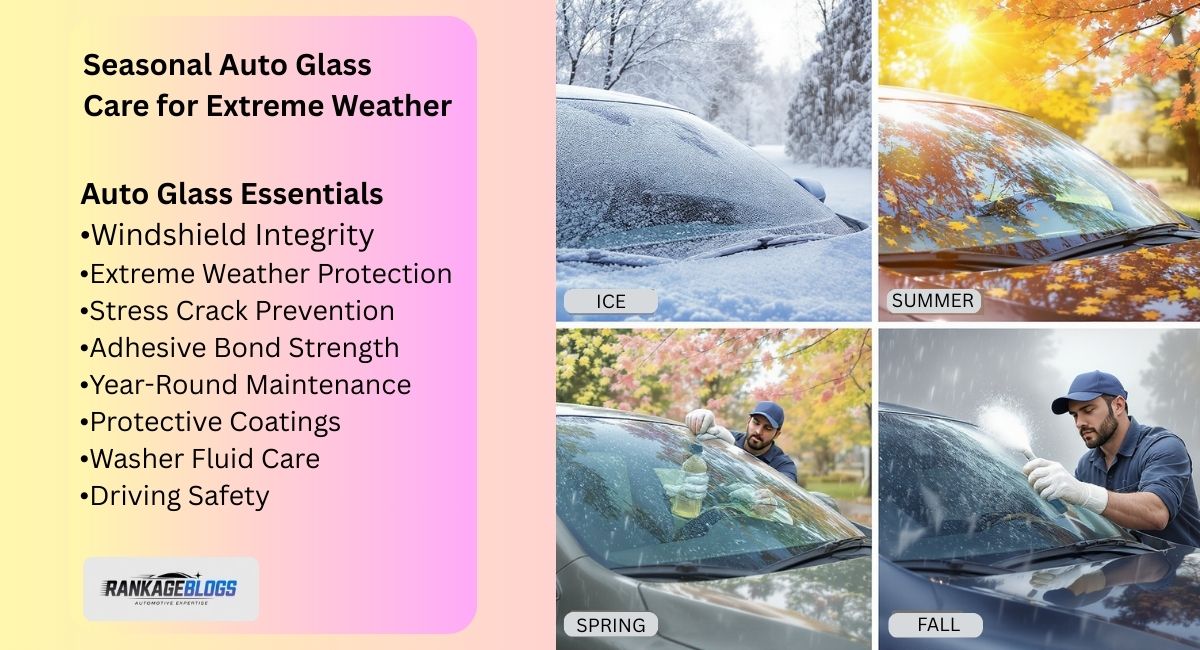Seasonal Auto Glass Care for Extreme Weather is vital for maintaining your vehicle’s windshield integrity and ensuring safe driving in all weather conditions. Extreme weather, including scorching summers, icy winters, spring storms, and fall temperature swings, can weaken adhesive bonds, cause stress cracks, and reduce overall glass durability.
Drivers who neglect seasonal maintenance may face costly repairs or visibility issues in critical driving situations. By following a structured windshield care routine, including protective coatings, appropriate washer fluids, and timely inspections, drivers can prevent minor damage from escalating. This guide provides actionable tips, highlights seasonal challenges, and ensures your auto glass remains safe, durable, and weather-resistant all year.
Seasonal Challenges for Auto Glass
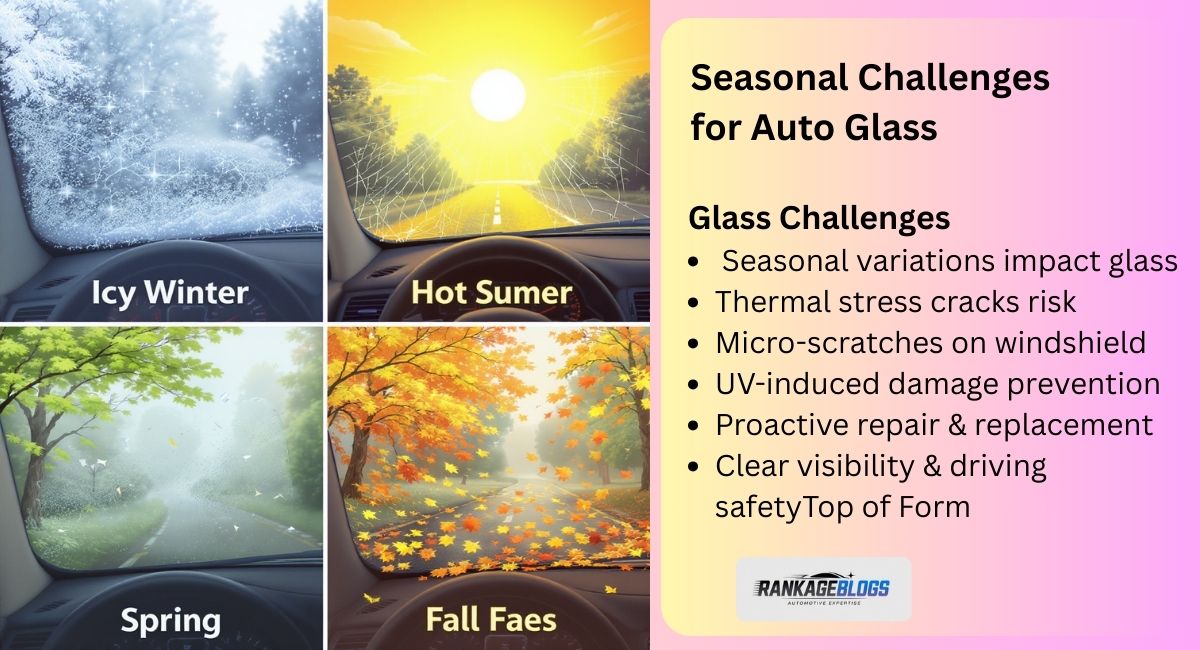
Seasonal variations dramatically affect your vehicle’s glass performance. Every season poses unique threats that require preventive windshield maintenance. From icy winters to scorching summers, proper care reduces the risk of thermal stress cracks, micro-scratches on the windshield, and UV-induced damage. Understanding seasonal risks allows you to implement auto glass repair and replacement strategies proactively and ensures clear visibility driving safety.
Winter Care
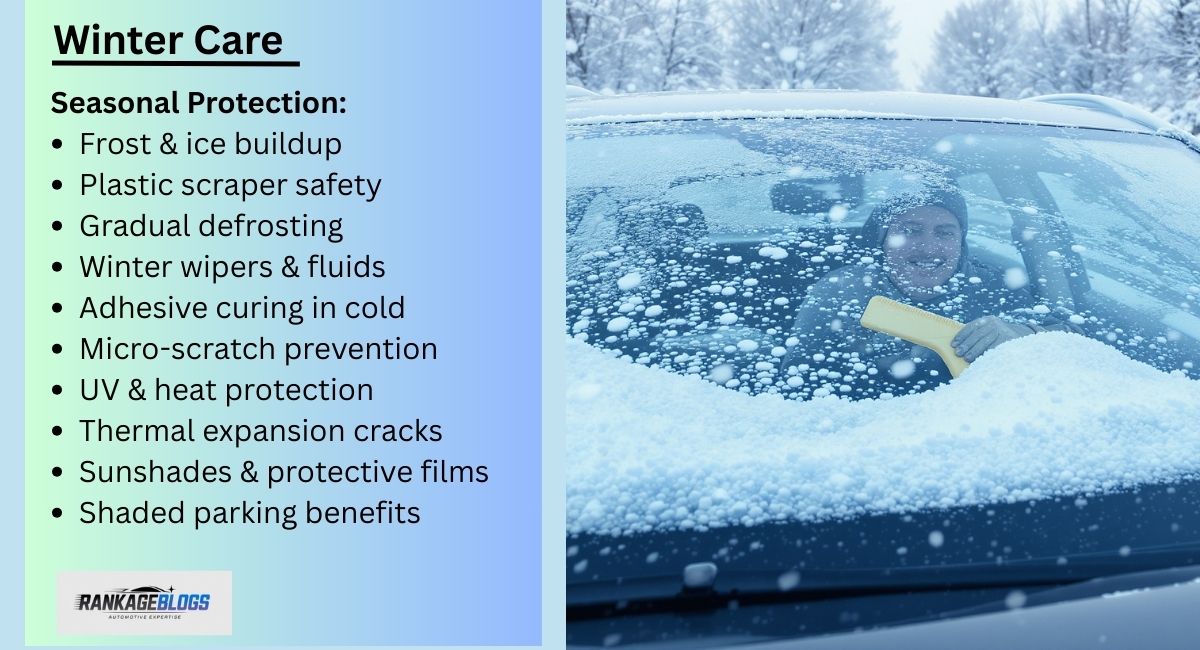
Winter presents multiple challenges for windshield safety in freezing temperatures, including frost, ice buildup, and cold-induced adhesive curing issues.
Ice Scraping Techniques and Frost Crack Prevention
Incorrect scraping creates micro-scratches on the windshield, which may develop into stress cracks during freeze-thaw cycles. Always use a plastic scraper instead of hot water to avoid rapid temperature change cracking glass. Remove ice gently layer by layer to avoid damaging the laminated glass with aggressive scraping. Applying de-icing spray for windshields before scraping softens frost, reducing scratches.
Seasonal Auto Glass Care for Extreme Weather ensures these preventive steps are followed to protect glass in winter. For heavily frozen windshields, allow the engine’s defroster safe heating protocol to gradually warm the glass and prevent sudden expansion. Proper winter scraping techniques improve windshield structural integrity and extend the lifespan of your auto glass.
Avoiding Thermal Shock with Gradual Defrost
Rapid expansion and contraction of glass cause thermal shock, leading to stress cracks. Avoid blasting the windshield with maximum heat immediately; instead, start with low temperature and gradually increase heat using the windshield defroster. Rapid temperature changes can crack the glass, especially when boiling water is used, which should always be avoided. Controlled defrosting prevents adhesive bonding issues affecting ADAS (Advanced Driver Assistance Systems) calibration sensors. Ensuring gradual heating preserves auto glass structural integrity, visibility and safety, and prevents expensive repair or replacement.
Winter Wiper Blades and Anti-freeze Washer Fluid
Using winter-specific wiper blades ensures that ice, frost, and snow are cleared effectively without scratching the glass. Standard wipers often crack in freezing conditions, causing windshield scratch risks from wipers. Combine wipers with winter windshield washer fluid, which resists freezing, removes road grime, and prevents road salt windshield damage. Seasonal wiper swaps maximize performance and protect against pothole impact on windshield due to reduced visibility. Proper wipers also help maintain foggy windshield prevention and ensure safe driving in icy road driving conditions.
Adhesive Curing Concerns in Freezing Temps
Extreme cold slows adhesive bonding, potentially compromising new windshield installations or repairs. When adhesives don’t cure correctly, it affects windshield structural integrity, airbag deployment & windshield integrity, and overall safety. Seasonal Auto Glass Care for Extreme Weather highlights the importance of allowing professional auto glass services to install windshields in controlled conditions and follow winter adhesive curing techniques. Avoid driving immediately after replacement in sub-zero conditions to prevent thermal stress.
Micro-scratches Caused by Improper Scraping
Excessive scraping or using metal tools can cause micro-scratches on windshield, creating microscopic chip stress concentrators. These can grow into windshield cracks and chips during freeze-thaw cycles. Using safe snow and ice removal tools for cars, combined with hydrophobic windshield coating benefits, minimizes scratch risks while maintaining vehicle glass safety in extreme climates.
Winter Washer Fluids for Better Performance
Winter-grade washer fluid prevents freezing and helps remove road salt and debris. Using fluids with anti-freeze components ensures clean windshields even in sub-zero conditions. Combine with water-repellent windshield treatment for improved visibility, reducing fogging and defogger system issues. Proper winter fluids maintain wiper functionality and prevent cold-weather damage.
Summer Care
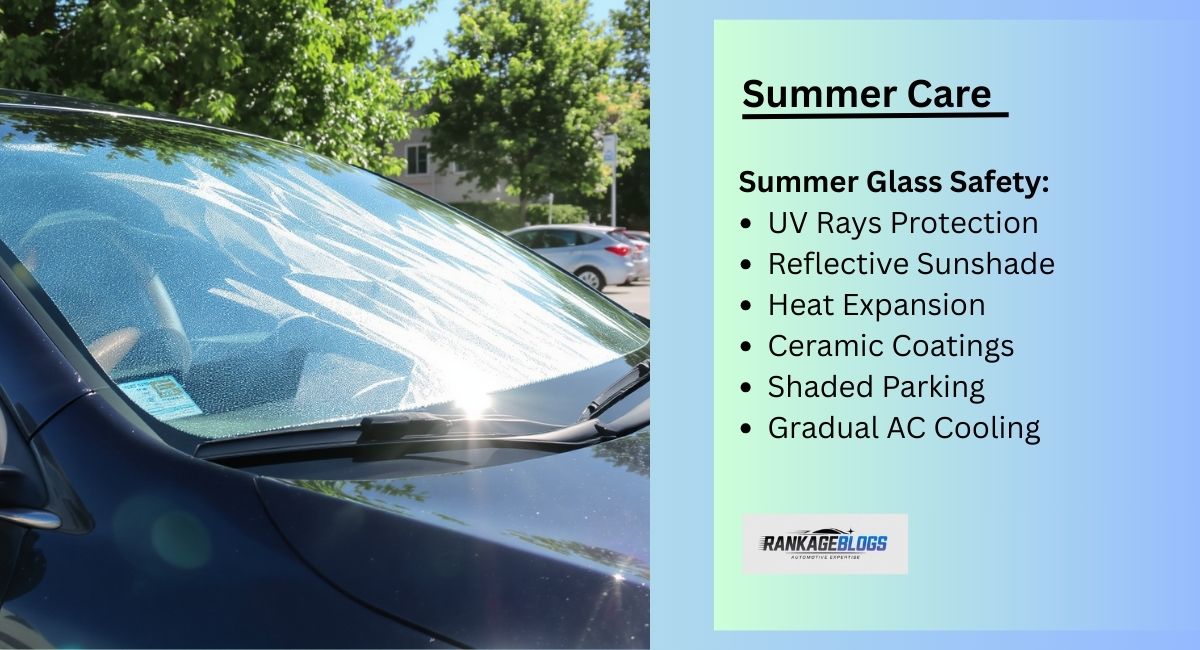
Summer exposes windshields to UV rays windshield damage and heat-related stress.
UV rays causing seal/adhesive weakening
High UV exposure weakens the windshield, deteriorating adhesive bonds and causing stress cracks. Prolonged exposure also affects the structural integrity of windshields.
Seasonal Auto Glass Care for Extreme Weather includes UV-protective treatments for windshields and automotive tinting films reduce sun damage prevention for cars and extend glass life. Always use reflective sunshades for heat protection when parked in direct sunlight.
Heat Expansion & Interior Pressure Cracks
Extreme heat makes glass expand and contract, creating stress cracks if ignored. Cabin heat builds up pressure on the windshield, potentially leading to heat-damaged windshields. Shaded parking and gradual AC cooling prevent glass cracks from rapid temperature changes.
Importance of Sunshades, UV-Protective Films, and Ceramic Coatings
Sunshade and shaded parking benefits reduce interior heat. Ceramic coatings protect against UV rays windshield damage, reduce glare, and prevent summer windshield care tips from being ignored. Protective films also maintain clear visibility and lasting performance.
Avoiding Sudden AC Blasts to Prevent Stress Cracks
Blasting cold air suddenly stresses a hot windshield. Gradually cool interiors to reduce expansion and contraction of glass. Windshield care in winter and summer principles overlap in preventing rapid temperature change cracking glass. Seasonal Auto Glass Care for Extreme Weather emphasizes these preventive measures for year-round protection.
Shaded Parking to Reduce Glass and Cabin Heat Damage
Shaded parking for summer protection helps prevent extreme heat windshield damage and reduces interior component wear. Combining this with UV-protective treatments for windshields ensures safe and enjoyable driving experience.
Spring Care
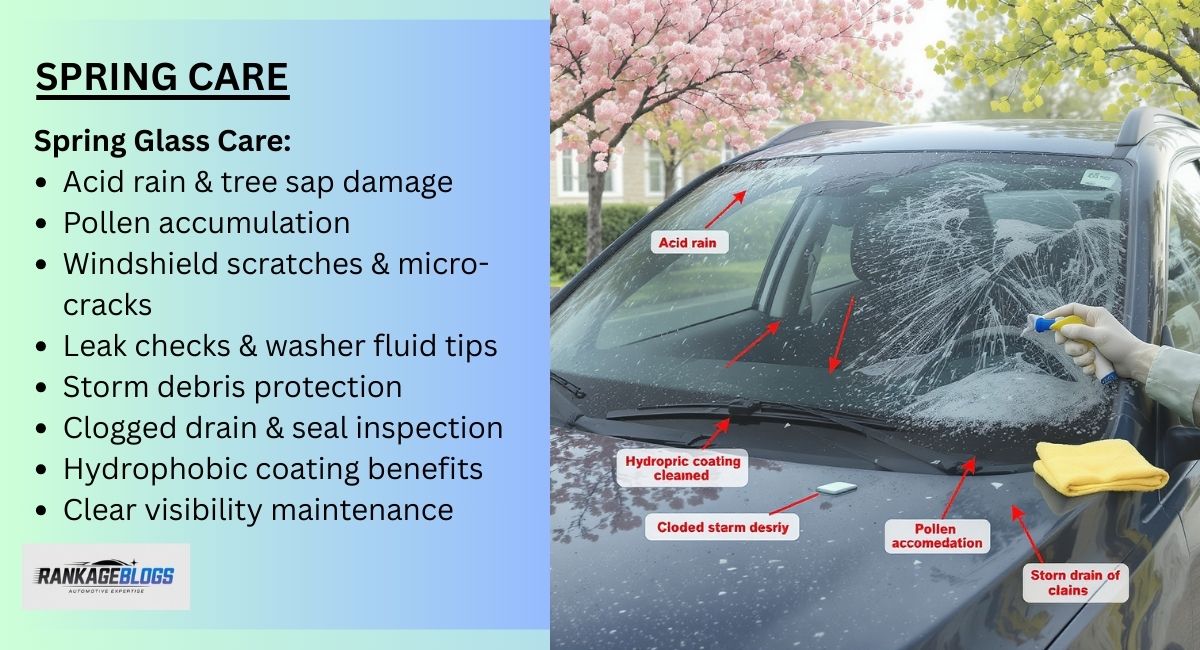
Spring brings rain, pollen, and debris hazards that can affect auto glass durability.
Acid rain, pollen, and tree sap damage
Acid rain and tree sap etch the windshield, causing scratches and micro-cracks. Pollen buildup reduces visibility, worsening safety during rainy seasons.. Using non-abrasive cleaners for car glass and frequent rinsing protects against UV and sunlight damage to glass while maintaining clear visibility driving safety. Early removal prevents windshield chips and cracks from spreading, safeguarding laminated glass durability.
Frequent Rains → Leak Checks, Washer Fluid Tips
Spring rains increase humidity impact on auto glass, raising the risk of leaks and water intrusion. Check seals, drains, and defogger system maintenance regularly. Using seasonal washer fluids ensures vehicle glass cleaning efficiency and prevents foggy windshield prevention. Proper fluid and cleaning habits mitigate rain, snow, and glass repair challenges.
Storm Debris Protection and Cleaning Guidance
Storms carry leaves, branches, and flying debris can cause damage, causing chips or cracks. Protect windshield from flying debris with storm season windshield covers during heavy rains or hailstorms. Cleaning promptly with non-abrasive cleaners prevents further stress cracks in auto glass.
Clogged Drains Check and Seal Inspection
Blocked drains trap water behind trim, weakening adhesives and causing leaks. Inspect windshield structural integrity, ensuring all seals are intact. Combine with seasonal windshield maintenance and a seasonal inspection checklist to prevent water-related auto glass damage prevention.
Pollen/sap visibility impact on driving safety
Accumulated pollen and sap reduce light transmission, increasing visibility and safety risks. Use routine auto glass cleaning techniques and hydrophobic windshield coating benefits to maintain a clear line of sight during spring drives.
Fall Care
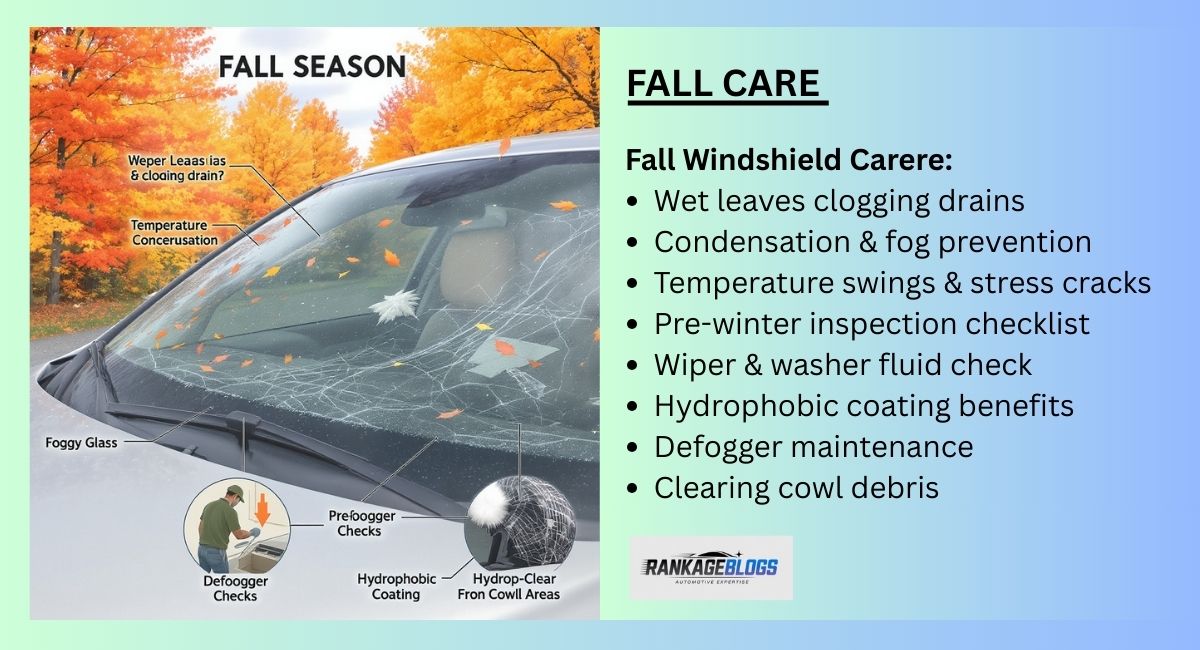
Fall introduces wet leaves, fog, and fluctuating temperatures, affecting auto glass care in extreme weather.
Wet Leaves Clogging Drains and Causing Leaks
Fallen leaves trap moisture near the windshield, increasing humidity and risking leaks. Clear drains and remove debris from cowl areas to protect adhesive bonding in extreme weather and maintain windshield structural integrity. Seasonal Auto Glass Care for Extreme Weather also emphasizes regular cleaning of these areas to avoid hidden damage and ensure long-term glass durability.
Condensation and Fog Prevention Strategies
Temperature swings rapidly create condensation inside the car. Ensure defogger system maintenance and use water-repellent windshield treatment to avoid foggy windshield prevention issues. Proper ventilation reduces thermal stress cracks.
Temperature Swings Causing Stress Cracks
Fall’s temperature fluctuations and auto glass contraction can lead to stress cracks in auto glass. Gradual heating and cooling prevent rapid temperature change cracking glass. Use UV-protective treatments for windshields to protect against late autumn sun exposure.
Pre-winter Inspection Checklist
Inspect windshield wiper maintenance, washer fluid freezing prevention, and check for small chips. Maintaining vehicle glass safety in extreme climates ensures clear visibility driving safety in upcoming winter months.
Condensation Inside and Foggy Glass Issues
Prevent interior fogging by monitoring defogger system maintenance and using hydrophobic windshield coating benefits. Ensure safe and enjoyable driving experience during damp fall mornings.
Defogger Check and Clearing Leaves from Cowl Area
Check the defogger system’s functionality, remove leaves and debris, and maintain windshield structural integrity. Routine auto glass cleaning techniques and seasonal inspection checklist help reduce foggy windshield prevention problems.
Extreme Weather Events
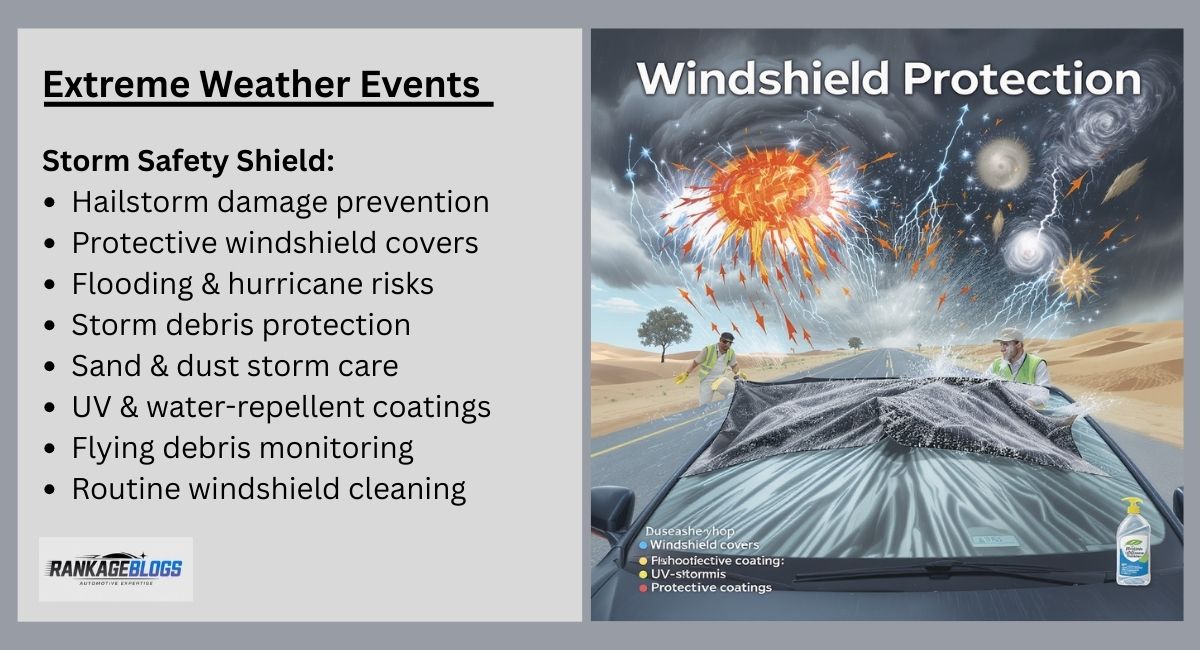
Extreme weather requires specialized preventive windshield measures and proactive auto glass care solutions.
Hailstorms → Protective Windshield Covers
Hail can cause hailstorm windshield impact leading to chips and cracks. Use protective windshield covers to prevent windshield cracks and chips. Covers combined with hydrophobic windshield coating benefits improve protection during hail events.
Hurricanes & Heavy Flooding Risks
Flooding and strong winds carry debris that can damage auto glass durability. Implement storm debris windshield damage protection and professional auto glass inspection services post-event to prevent windshield structural integrity issues.
Sand/dust Storms in Desert Regions
Sandstorms accelerate sand scratches and extreme heat windshield damage. Clean frequently using non-abrasive cleaners and protect with hydrophobic coatings. Climate zone impact on vehicles guides seasonal auto glass care tips for desert regions.
Flying Debris in Storm-prone Areas
Flying debris during storms increases windshield crack risks. Use protective covers and monitor windshield chips and cracks repair options. Regular professional windshield inspection ensures safety.
Protective Coatings + Frequent Cleaning in Dust Storms
Apply UV-protective treatments for windshields and water-repellent windshield coating for dust and debris resistance. Maintain clear visibility driving safety through routine auto glass cleaning techniques.
Environmental & Regional Considerations
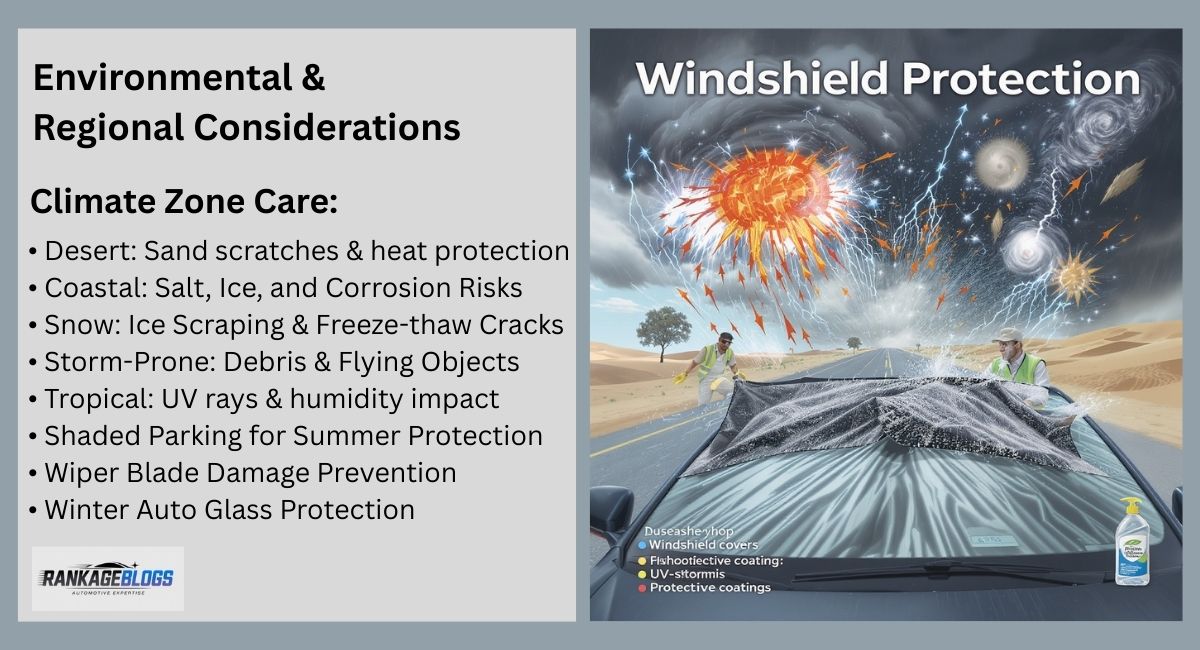
Different climates require tailored seasonal auto glass care.
Climate Zone Impact
- Desert regions: sand scratches, heatwave effects on windshields, shaded parking for summer protection.
- Coastal regions: salt and ice chemical damage, humidity impact on auto glass, road salt corrosion, wiper blade damage.
- Snow regions: ice scraping techniques, freeze-thaw cycles that cause windshield cracks, winter auto glass protection.
- Storm-prone regions: storm debris windshield damage, flying debris in storm-prone areas, insurance claim processing auto glass.
- Tropical climates: UV rays windshield damage, humidity impact on auto glass, summer windshield care tips.
Preventive Care & Seasonal Auto Glass Care for Extreme Weather Tools
Seasonal Checklist for Drivers
- Covered parking benefits
- Gradual heating/cooling for thermal stress prevention
- Seasonal wiper swaps: winter vs summer blades
- Proper washer fluids: anti-freeze, bug remover
- Routine cleaning and inspections
Protective Products & Add-ons
- Hydrophobic coatings & glass sealants
- Ceramic/UV-protective films
- De-icing sprays vs scraping
- Protective covers for hail/flood
Driving & Usage Habits
- Avoid thermal shock: summer AC / winter defrost
- Safe driving in rain, hail, fog
- Emergency fixes: temporary sealants, protective films, DIY kits, glass-safe tapes
Modern Auto Glass Needs
- ADAS calibration after windshield stress or replacement
- Care for side, rear, and sunroof glass
- Professional inspections and repair
Professional & Insurance Guidance
- Seasonal inspections pre/post harsh weather
- Professional adhesive curing techniques in hot/cold climates
- Insurance coverage for hail, floods, and storms
- Clear DIY vs professional repair boundaries
Long-Term Maintenance & Value
- Regular seasonal care extends windshield life
- Cost-saving strategies: maintenance vs replacement
- Safety benefits → reduced accident risk due to poor visibility
Conclusion
Maintaining your vehicle’s auto glass throughout the year is crucial for ensuring safety, visibility, and windshield longevity. Seasonal challenges—from icy winters and scorching summers to spring storms and fall temperature swings—can weaken adhesive bonds, cause stress cracks, and reduce overall glass durability.
Drivers who follow a comprehensive routine—using protective coatings, proper washer fluids, safe scraping, and regular inspections—can prevent minor issues from becoming costly repairs. Seasonal Auto Glass Care for Extreme Weather further helps tailor your maintenance to regional climates and extreme weather events, ensuring your auto glass remains resilient, clear, and structurally sound, providing peace of mind and safe driving in every season.
Final Thoughts
Seasonal auto glass care is not just about protecting your vehicle’s appearance—it directly impacts safety, visibility, and long-term durability. Understanding how each season affects windshields, from winter frost and ice to summer heat and UV exposure, allows drivers to adopt preventive measures that minimize damage.
Seasonal Auto Glass Care for Extreme Weather includes simple practices such as using hydrophobic coatings, seasonal wiper swaps, protective films, and gradual defrosting or cooling can dramatically extend the life of your auto glass. Pairing routine maintenance with professional inspections ensures structural integrity and proper ADAS calibration. By prioritizing year-round care, you safeguard both your vehicle and your driving experience, keeping your windshield resilient in all weather conditions.
FAQs
- Can you do windshield repair in cold weather?
Yes, but extreme cold may affect adhesive curing; professional cold-weather repair kits are recommended. - How to protect auto glass?
Use protective coatings, park in shaded or covered areas, and avoid sudden temperature changes. - Can a technician replace a windshield in cold weather?
Yes, A technician can replace windshields in cold weather using adhesives suitable for lower temperatures. - What temperature does it have to be to install a windshield?
The ideal temperature for windshield installation is 60°F to 80°F (15°C to 27°C), with 40°F–90°F (4°C–32°C) acceptable using proper adhesives and precautions. - How to prepare a windshield for winter?
Clean thoroughly, apply water-repellent coating, check wipers, and top up winter washer fluid. - Can I use Permatex windshield repair kit in cold weather?
Yes, but performance may decrease in very low temperatures. - How cold does it have to be for frost to form on a windshield?
Frost typically forms on a windshield when the temperature drops to 32°F (0°C) or below, especially on clear, calm nights. - What is the ideal temperature for windshield repair?
The ideal temperature for windshield repair is 60°F–100°F (15°C–38°C), with 70°F–100°F (21°C–38°C) being optimal for proper resin curing and a long-lasting fix. - Do windshields crack more in heat or cold?
Windshields can crack in both heat and cold: cold expands existing chips during contraction, while heat causes thermal stress that worsens cracks, especially at edges. - What temperature should I set it to stop condensation in the windshield?
Set the car’s interior temperature to around 70°F–75°F (21°C–24°C) and use the defroster to prevent windshield condensation effectively. - How to stop condensation on car windows overnight in winter?
Keep windows slightly open, use a dehumidifier, or park in a garage. - How to keep windshield from fogging up without heat?
Apply anti-fog sprays or use water-repellent coatings. - Does shaving cream stop windows from fogging?
Yes, a thin layer of shaving cream can act as a temporary anti-fog treatment.

